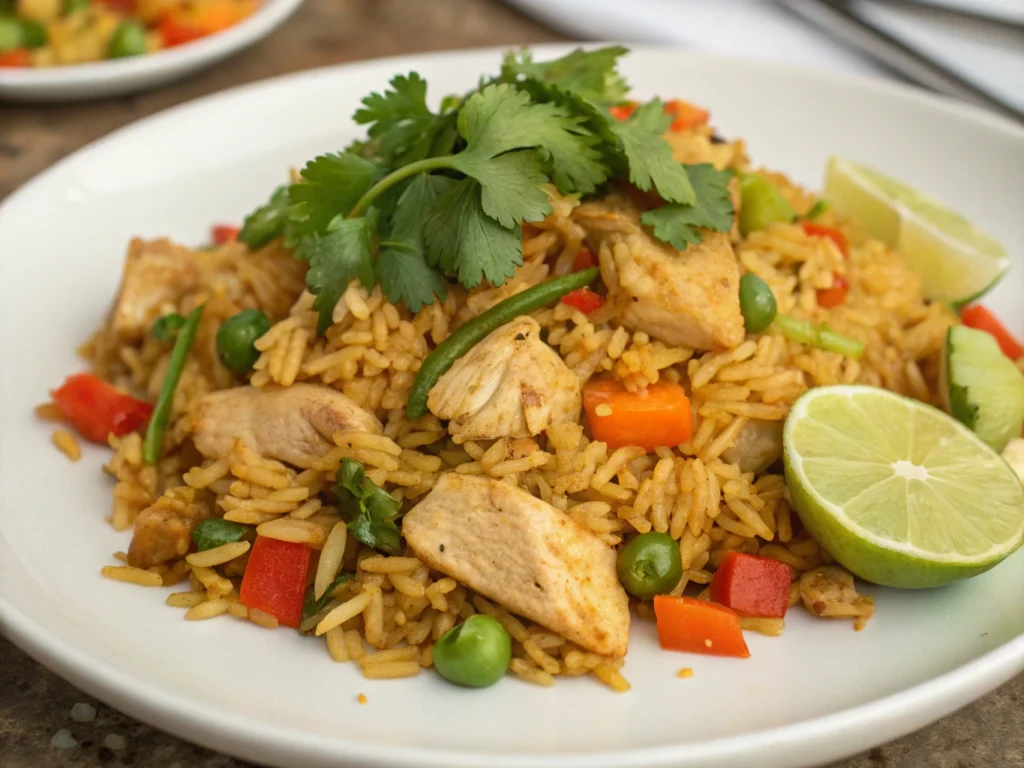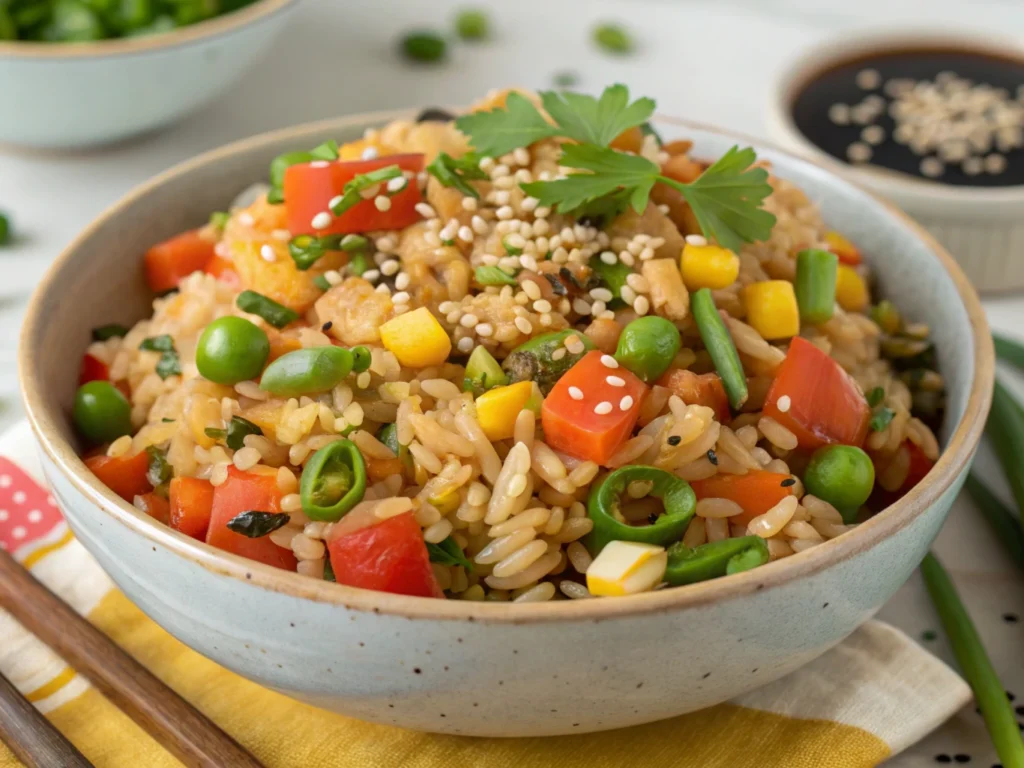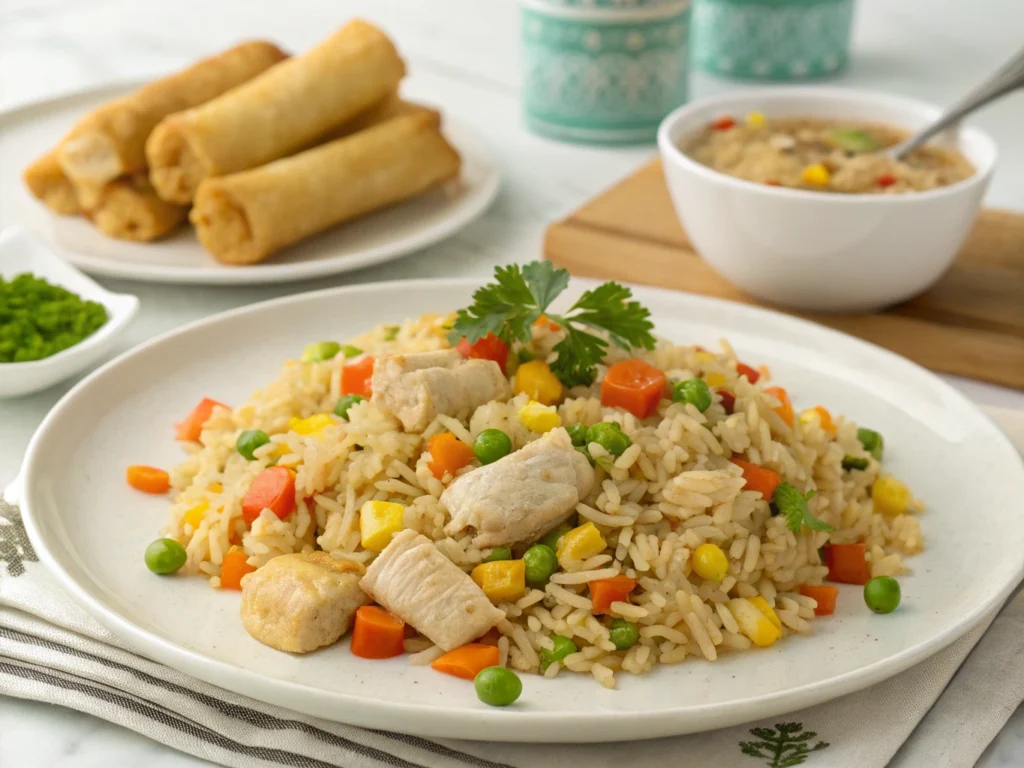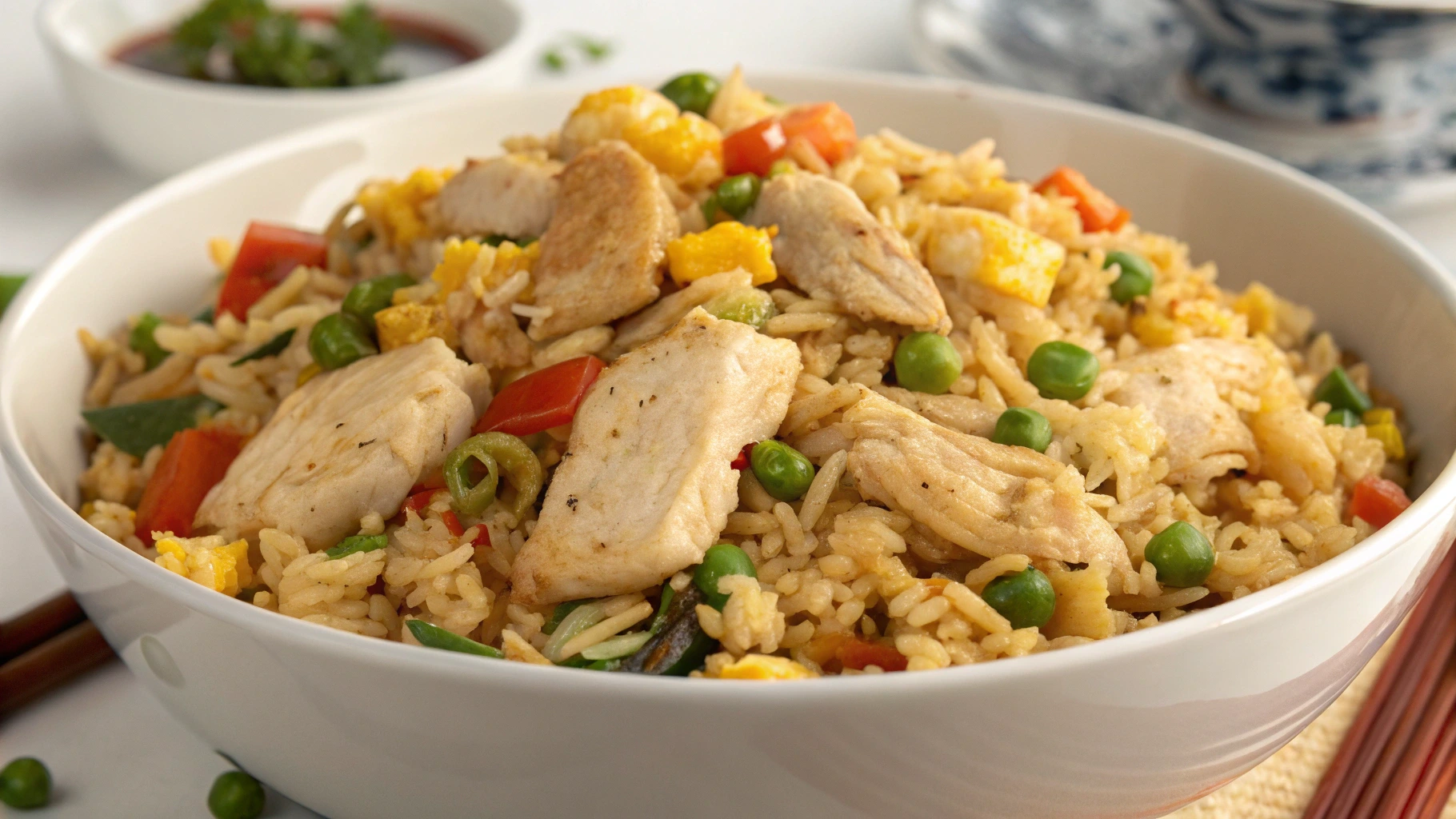Chicken fried rice is more than just a delicious, comforting dish; it’s a culinary story that spans centuries and continents. From its humble beginnings in ancient China to its modern-day global adaptations, this dish showcases a fascinating journey of cultural exchange and innovation. In this article, we’ll dive into the roots of fried rice, explore its regional variations, and uncover its cultural significance in different parts of the world. Along the way, we’ll answer the question, “What culture is chicken fried rice from?” while highlighting its profound impact on culinary traditions.
Part 1: The Origins of Chicken Fried Rice
The Sui Dynasty and the Birth of Fried Rice
Chicken fried rice traces its roots back to the Sui dynasty (581–618 CE) in ancient China. During this period, food waste was frowned upon, prompting people to find creative ways to repurpose leftovers. Enter fried rice—an ingenious dish born from reheating cold rice with whatever ingredients were available, like vegetables, meat, and spices.
The use of stir-frying, a cooking method pivotal to making fried rice, was already well-established in Chinese cuisine by this time. This technique allowed cooks to prepare meals quickly while retaining the flavors and textures of the ingredients. Fried rice wasn’t just a dish; it was an early testament to the resourcefulness and practicality of Chinese cooking.
The Ming Dynasty’s Influence on Fried Rice Popularity
While fried rice was born during the Sui dynasty, it truly gained prominence during the Ming dynasty (1368–1644). Southern China, in particular, became synonymous with this dish, as families began adding unique touches to their recipes. Fried rice transformed from a simple leftover dish into a beloved culinary staple, with ingredients like soy sauce, garlic, and spring onions lending distinct flavors.
This period also saw the emergence of Yangzhou fried rice, a regional favorite known for its colorful mix of barbecued pork, shrimp, and peas. This variant would later become a template for many global adaptations.
The Role of Wok and Stir-Frying in Early Chinese Cuisine
Central to the creation of fried rice is the wok, a versatile cooking vessel that has been a cornerstone of Chinese kitchens for centuries. Its ability to distribute heat evenly made it ideal for stir-frying, a method that combines speed and high temperatures to lock in flavors.
The wok’s design allowed cooks to toss and mix ingredients efficiently, ensuring that every grain of rice was coated with seasoning while preventing sticking. This practice laid the groundwork for fried rice’s characteristic smoky aroma, known as wok hei (or “breath of the wok”), which remains a hallmark of traditional fried rice to this day.
By combining simple ingredients, practical cooking techniques, and the creativity of early Chinese cooks, fried rice evolved into a dish that reflects the ingenuity of Chinese culinary culture.
Chicken Fried Rice in Chinese Culture
Significance of Fried Rice in Southern China
Southern China holds a special place in the story of fried rice. This region’s climate is ideal for rice cultivation, making rice the foundation of many meals. Over time, fried rice emerged as a versatile way to repurpose leftover rice while showcasing the unique flavors of the region.
In this area, families often added seafood like shrimp or scallops to their fried rice, reflecting their proximity to the coast. Vegetables such as peas, carrots, and green onions were included for both flavor and color, turning a simple dish into a feast for the eyes and palate. This regional style highlights how Chinese culinary traditions prioritize balance, not just in taste but in presentation.
Regional Variations in Chinese Fried Rice
China’s vast geography and diverse cultures have given rise to distinct styles of fried rice. For instance, Yangzhou fried rice from Jiangsu Province is known for its combination of barbecued pork, shrimp, and eggs, often served at banquets to impress guests.
Meanwhile, in Sichuan, spicy fried rice incorporates Sichuan peppercorns for a bold and fiery kick. This version reflects the region’s love for heat in their dishes. These variations show how a single dish can adapt to local tastes and resources, embodying the ingenuity of Chinese cuisine.
Symbolism and Cultural Value in Traditional Festivities
Fried rice plays a symbolic role in Chinese celebrations, particularly during the Lunar New Year. It’s believed to represent good fortune and abundance, with ingredients like eggs symbolizing gold and prosperity. Adding shrimp or lobster to the dish is thought to signify happiness and success.
This dish is not just about sustenance—it’s a way of preserving cultural traditions and passing them on through generations. Asking, “What culture is chicken fried rice from?”, reveals a deeper connection to Chinese values of thrift, creativity, and family unity.
Spread of Fried Rice to Southeast Asia

Adapting Fried Rice in Thailand: Khao Pad
When fried rice made its way to Thailand, it evolved into Khao Pad, a local favorite. Thai cooks introduced fish sauce, lime juice, and fragrant jasmine rice into the recipe, giving it a distinctive sweet and savory profile. Unlike its Chinese counterpart, Khao Pad is often garnished with fresh herbs like cilantro and served with a wedge of lime for an extra burst of flavor.
The adaptability of fried rice shows its universal appeal. In Thailand, cooks added local ingredients to create a dish that feels authentic yet retains its Chinese roots. This fusion exemplifies how fried rice adapts to different cultures, blending traditions seamlessly.
Indonesia’s Nasi Goreng and Local Flavor Additions
In Indonesia, fried rice became Nasi Goreng, a dish beloved for its smoky aroma and bold flavors. Indonesians added kecap manis (a sweet soy sauce), shrimp paste, and chili peppers to create a taste that’s uniquely theirs. Often topped with a fried egg or accompanied by pickled vegetables, Nasi Goreng is a staple of Indonesian street food and home cooking.
This version of fried rice underscores the versatility of the dish. As fried rice spread across Southeast Asia, it absorbed each culture’s culinary traditions while retaining its Chinese origins.
Sinangag in the Philippines: A Garlic-Infused Breakfast Dish
In the Philippines, fried rice transformed into Sinangag, a simpler yet flavorful garlic fried rice. It’s typically eaten for breakfast alongside fried eggs, cured meats, or dried fish. Sinangag showcases how a humble dish can evolve to meet the specific needs of a culture, serving as a quick and satisfying meal to start the day.
The question, “What culture is chicken fried rice from?” becomes even more intriguing when exploring its Southeast Asian adaptations. Each version is a testament to how fried rice transcends borders, blending seamlessly into the fabric of diverse culinary traditions.
Fusion of Fried Rice in Western Cuisine
Introduction of Fried Rice by Chinese Immigrants
The migration of Chinese communities to the West played a pivotal role in introducing fried rice to new audiences. Immigrants brought their culinary traditions, including fried rice, to places like the United States and Europe, where the dish found a warm reception.
In America, Chinatowns became hubs of cultural exchange, with restaurants serving authentic Chinese dishes. Fried rice was particularly appealing because of its adaptability; diners could enjoy it as a side or a main dish, making it a popular choice.
Pioneers Like Joyce Chen and Cecilia Chiang
The rise of Chinese-American chefs like Joyce Chen and Cecilia Chiang further solidified fried rice’s place in Western cuisine. These trailblazers adapted traditional recipes to suit Western palates, introducing milder flavors while retaining the dish’s authenticity.
Their cookbooks and TV appearances helped demystify Chinese cooking techniques, encouraging home cooks to try dishes like fried rice. Today, many Western adaptations of fried rice can be traced back to these early efforts.
Western Adaptations: Blending Cultures and Palates
Western interpretations of fried rice have created some unique and exciting variations. In fusion cuisine, chefs experiment with ingredients like Cajun spices, pineapple, and even bacon to cater to local tastes.
These adaptations highlight the versatility of fried rice while sparking the question, “What culture is chicken fried rice from?”. The answer lies in its Chinese roots, but its global appeal shows how food can transcend borders.
For a closer look at modern takes on Asian-inspired dishes, check out the Chicken Fried Rice Recipe on DeliciouRecipes.
Chicken Fried Rice in Modern Times
Global Fusion Dishes Inspired by Fried Rice
Fried rice continues to inspire chefs around the world. From kimchi fried rice in Korea to Tex-Mex fried rice in the United States, the dish has become a canvas for creative experimentation. These global twists often incorporate local ingredients, resulting in exciting new flavors while maintaining the essence of fried rice.
In Hawaii, for instance, adding Spam and pineapple creates a sweet-savory harmony, while in India, spices like turmeric and cumin bring a bold twist. This fusion of flavors demonstrates the universal appeal of fried rice.
Contemporary Trends: Health-Conscious Variations

Modern food trends have given rise to healthier versions of fried rice. Substituting white rice with quinoa or cauliflower rice caters to health-conscious eaters, while vegan adaptations use tofu or plant-based proteins.
These trends reflect how the dish evolves to meet contemporary demands while staying true to its heritage. The question, “What culture is chicken fried rice from?”, underscores how a dish deeply rooted in Chinese tradition continues to innovate globally.
The Dish’s Role in Bridging Cultures
Fried rice serves as a culinary bridge, connecting people through shared flavors and traditions. Its journey from Chinese kitchens to international menus shows how food fosters cultural exchange.
The dish’s popularity across diverse communities is a testament to its ability to bring people together, regardless of their background. For those curious about more Asian-inspired recipes, DeliciouRecipes offers a range of options to explore.
Notable Fried Rice Recipes Across Cultures
Yangzhou Fried Rice: A Classic Chinese Recipe
One of the most famous versions of fried rice is Yangzhou fried rice, originating from Jiangsu Province in China. This dish is known for its vibrant colors and balanced flavors, combining barbecued pork, shrimp, peas, and scrambled eggs. Its elegant simplicity makes it a favorite at banquets and celebrations.
Yangzhou fried rice perfectly illustrates the ingenuity of Chinese cooking. It transforms simple ingredients into a harmonious dish that reflects the culture’s culinary artistry. This traditional recipe answers the question, “What culture is chicken fried rice from?”, by showcasing its deeply rooted Chinese heritage.
Khao Pad and Lime: A Thai Specialty
Thailand’s twist on fried rice, Khao Pad, incorporates fish sauce, lime juice, and jasmine rice to create a unique sweet and savory flavor profile. Often garnished with fresh herbs like cilantro and served with a lime wedge, Khao Pad demonstrates how Thai cooks adapted the dish to their local palate.
This variation highlights the adaptability of fried rice, which has evolved to fit the tastes of diverse cultures while retaining its original essence.
Kimchi Fried Rice: A Korean Twist
In Korea, fried rice meets the bold flavors of kimchi, the country’s iconic fermented cabbage. Kimchi fried rice is a spicy, tangy, and slightly sweet dish that adds a flavorful punch to the traditional recipe. Often topped with a fried egg, this version reflects Korean cuisine’s emphasis on robust and complex flavors.
Cajun Seafood Fried Rice: Fusion from the USA
The United States has embraced fried rice as a fusion food, creating dishes like Cajun seafood fried rice. By blending bold Cajun spices with shrimp, crab, andouille sausage, and rice, this variation delivers a uniquely American take on a Chinese classic.
Each of these recipes underscores the global appeal of fried rice. They show how different cultures have embraced and personalized this versatile dish while staying true to its roots.
Cultural Significance of Chicken Fried Rice
Celebratory Context in Chinese Festivals
In Chinese culture, fried rice is more than just a dish—it’s a symbol of prosperity and celebration. During the Lunar New Year, families prepare elaborate versions of fried rice to symbolize wealth and abundance. Ingredients like shrimp, lobster, and colorful vegetables are chosen for their auspicious meanings.
This connection to festivals underscores how fried rice represents more than nourishment; it’s a reflection of cultural values and traditions.
Ingredient Symbolism in Fried Rice
The ingredients in fried rice often carry symbolic meanings. For example, eggs represent gold and prosperity, while the vibrant mix of vegetables signifies harmony and balance. This symbolism adds depth to the question, “What culture is chicken fried rice from?”, as it reveals the dish’s integral role in expressing Chinese cultural beliefs.
Family Bonds and Culinary Traditions

Fried rice is also a dish that brings families together. Preparing it often involves collaboration, with family members contributing to chopping, cooking, and serving. It’s a reminder of the importance of unity and shared experiences in Chinese culture.
Across cultures, fried rice continues to serve as a medium for connection, celebration, and creativity. It’s a testament to how food can bridge gaps and foster understanding.

